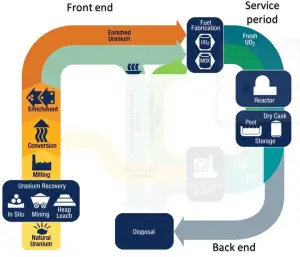Radioactive waste is any waste that contains radioactive material. Radioactive (or nuclear) waste is a byproduct of nuclear reactors, fuel processing plants, hospitals, various industrial applications, and research facilities. Radioactive waste is hazardous to most forms of life and the environment and is regulated by government agencies to protect human health and the environment.
Final Disposal
Final disposal, or permanent disposal, is a final stage of the back end of the nuclear fuel cycle. Final disposal is unavoidable and common for all the strategies of nuclear fuel cycles, despite the reduction in waste volume and radiotoxicity with current or future reprocessing techniques. This last step is the final disposal of the waste. Whether untreated spent nuclear fuel or vitrified high-level waste from fuel reprocessing, it is still necessary to safely store them for the long term until their radioactivity reaches safe levels. However, the period they require safe storage depends on reprocessing technologies. For example, the once-through cycle comprises two main back-end stages:
- interim storage
- final disposal.

In these cases, the fuel assemblies are first after irradiation stored in spent fuel pools at the reactor site for an initial cooling period. Over time, as the spent fuel is stored in the pool, it becomes cooler as the radioactivity decays away. After several years (> 5 years), decay heat decreases under specified limits so that spent fuel may be interim storage. Interim storage can be either at the power plant site or at a centralized location that stores the fuel from more than one power plant. After a minimum period of 50 to 100 years of interim storage, spent nuclear fuel must be transferred to a final disposal facility. The preferred option is a deep geological repository (DGR), an underground emplacement in stable geological formations. Crystalline rock (granite, welded tuff, and basalt), salt, and clay are the most suitable formations for geological disposal. The once-through cycle considers the spent nuclear fuel to be high-level waste (HLW) and, consequently, it is directly disposed of in a storage facility without being put through any chemical processes, where it will be safely stored for millions of years until its radiotoxicity reaches natural uranium levels or another safe reference level.
This strategy is favored by several countries: the United States, Canada, Sweden, Finland, Spain, and South Africa. Some countries, notably Finland, Sweden, and Canada, have designed repositories to permit future material recovery should the need arise. In contrast, others plan for permanent sequestration in a geological repository like the Yucca Mountain nuclear waste repository in the United States.
Deep Geological Repository
A deep geological repository (DGR) is a radioactive waste repository excavated deep within a stable geologic environment (typically below 300 m or 1000 feet). A deep geological repository may be used as the final disposal of untreated spent nuclear fuel or vitrified high-level waste arising from fuel reprocessing. Deep disposal in a mined repository is now the preferred option for HLW final disposal in most countries. The Waste Isolation Pilot Plant (WIPP) deep geological waste repository operates in the US to dispose of transuranic waste – long-lived ILW from military sources contaminated with plutonium.
A deep geological repository entails a combination of waste form, waste package, engineered seals, and geology suited to provide a high level of long-term isolation and containment without future maintenance. Crystalline rock (granite, welded tuff, and basalt), salt, and clay are the most suitable formations for geological disposal. For example, the once-through cycle considers the spent nuclear fuel to be high-level waste (HLW) and, consequently, it is directly disposed of in a storage facility without being put through any chemical processes, where it will be safely stored for millions of years until its radiotoxicity reaches natural uranium levels or another safe reference level.
This strategy is favored by several countries: the United States, Canada, Sweden, Finland, Spain, and South Africa. Some countries, notably Finland, Sweden, and Canada, have designed repositories to permit future material recovery should the need arise. In contrast, others plan for permanent sequestration in a geological repository like the Yucca Mountain nuclear waste repository in the United States.
Natural precedents for geological disposal – Oklo Reactor
It must be noted that nature has already proven that geological isolation of radioactive material is possible through several natural examples (or ‘analogs’). One of the most important cases is the natural nuclear reactor in Oklo. The world’s first nuclear reactor operated about two billion years ago (at that time the concentration of U-235 in all natural uranium was about 3%). The natural nuclear reactor formed at Oklo in Gabon, Africa, when a uranium-rich mineral deposit became flooded with groundwater that acted as a neutron moderator, and a nuclear chain reaction started. These fission reactions were sustained for hundreds of thousands of years until a chain reaction could no longer be supported. This was confirmed by the existence of isotopes of the fission-product gas xenon and by different ratios of U235/U238 (enrichment of natural uranium).
During this spontaneous fission, all the radionuclides found in HLW were also produced, including over 5 tonnes of fission products and 1.5 tonnes of plutonium, all of which remained at the site and eventually decayed into non-radioactive elements. Studying such natural phenomena is important for assessing geologic repositories and is the subject of several international research projects.